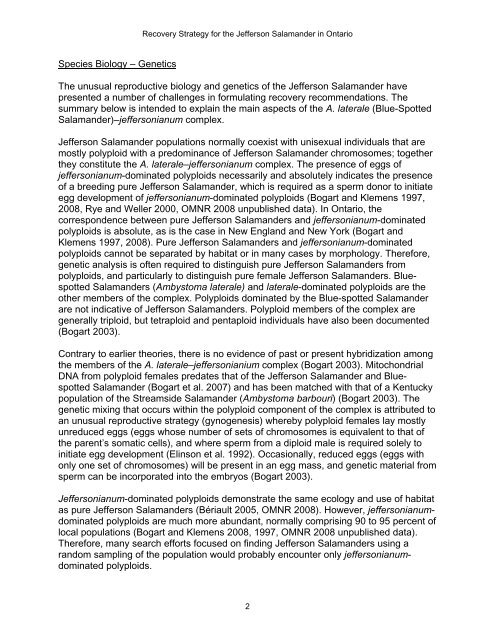Jefferson Salamander - Amphibian Specialist Group
Jefferson Salamander - Amphibian Specialist Group
Jefferson Salamander - Amphibian Specialist Group
You also want an ePaper? Increase the reach of your titles
YUMPU automatically turns print PDFs into web optimized ePapers that Google loves.
Recovery Strategy for the <strong>Jefferson</strong> <strong>Salamander</strong> in OntarioSpecies Biology – GeneticsThe unusual reproductive biology and genetics of the <strong>Jefferson</strong> <strong>Salamander</strong> havepresented a number of challenges in formulating recovery recommendations. Thesummary below is intended to explain the main aspects of the A. laterale (Blue-Spotted<strong>Salamander</strong>)–jeffersonianum complex.<strong>Jefferson</strong> <strong>Salamander</strong> populations normally coexist with unisexual individuals that aremostly polyploid with a predominance of <strong>Jefferson</strong> <strong>Salamander</strong> chromosomes; togetherthey constitute the A. laterale–jeffersonianum complex. The presence of eggs ofjeffersonianum-dominated polyploids necessarily and absolutely indicates the presenceof a breeding pure <strong>Jefferson</strong> <strong>Salamander</strong>, which is required as a sperm donor to initiateegg development of jeffersonianum-dominated polyploids (Bogart and Klemens 1997,2008, Rye and Weller 2000, OMNR 2008 unpublished data). In Ontario, thecorrespondence between pure <strong>Jefferson</strong> <strong>Salamander</strong>s and jeffersonianum-dominatedpolyploids is absolute, as is the case in New England and New York (Bogart andKlemens 1997, 2008). Pure <strong>Jefferson</strong> <strong>Salamander</strong>s and jeffersonianum-dominatedpolyploids cannot be separated by habitat or in many cases by morphology. Therefore,genetic analysis is often required to distinguish pure <strong>Jefferson</strong> <strong>Salamander</strong>s frompolyploids, and particularly to distinguish pure female <strong>Jefferson</strong> <strong>Salamander</strong>s. Bluespotted<strong>Salamander</strong>s (Ambystoma laterale) and laterale-dominated polyploids are theother members of the complex. Polyploids dominated by the Blue-spotted <strong>Salamander</strong>are not indicative of <strong>Jefferson</strong> <strong>Salamander</strong>s. Polyploid members of the complex aregenerally triploid, but tetraploid and pentaploid individuals have also been documented(Bogart 2003).Contrary to earlier theories, there is no evidence of past or present hybridization amongthe members of the A. laterale–jeffersonianium complex (Bogart 2003). MitochondrialDNA from polyploid females predates that of the <strong>Jefferson</strong> <strong>Salamander</strong> and Bluespotted<strong>Salamander</strong> (Bogart et al. 2007) and has been matched with that of a Kentuckypopulation of the Streamside <strong>Salamander</strong> (Ambystoma barbouri) (Bogart 2003). Thegenetic mixing that occurs within the polyploid component of the complex is attributed toan unusual reproductive strategy (gynogenesis) whereby polyploid females lay mostlyunreduced eggs (eggs whose number of sets of chromosomes is equivalent to that ofthe parent’s somatic cells), and where sperm from a diploid male is required solely toinitiate egg development (Elinson et al. 1992). Occasionally, reduced eggs (eggs withonly one set of chromosomes) will be present in an egg mass, and genetic material fromsperm can be incorporated into the embryos (Bogart 2003).<strong>Jefferson</strong>ianum-dominated polyploids demonstrate the same ecology and use of habitatas pure <strong>Jefferson</strong> <strong>Salamander</strong>s (Bériault 2005, OMNR 2008). However, jeffersonianumdominatedpolyploids are much more abundant, normally comprising 90 to 95 percent oflocal populations (Bogart and Klemens 2008, 1997, OMNR 2008 unpublished data).Therefore, many search efforts focused on finding <strong>Jefferson</strong> <strong>Salamander</strong>s using arandom sampling of the population would probably encounter only jeffersonianumdominatedpolyploids.2
















